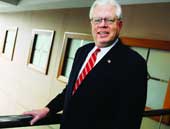M&A Special Report: The art of the deal

To create a masterpiece, dealmakers track rumors, court suitors and put in long hours.
The rumors started soon after General Dynamics Corp. announced it was buying Anteon International Corp. The market buzz was that some part of Anteon would have to be jettisoned to address concerns about conflicts of interest.Bahman Atefi, chairman and chief executive officer of Alion Science and Technology Corp., and his team were instantly intrigued by the rumors because of their familiarity with Anteon's work for the Navy. Atefi received monthly updates and watched as the rumor mill cranked out ever-growing numbers of how much of Anteon General Dynamics would have to give up. Early estimates of $25 million grew to $40 million and then jumped to more than $100 million."I began to worry because I was afraid it might get too big for us," Atefi said.The conflict of interest came because General Dynamics was the prime contractor on projects for which Anteon did project management work. When the rumors turned to fact, the Anteon business that needed to be sold off pulled in $240 million a year in engineering and program management with the Navy and Air Force."This was a whole different ballgame," Atefi said. Not only was the acquisition the largest of 11 deals Alion had closed in the last three years, but the company faced a compressed timeframe for getting it done.But get it done they did, closing a deal with General Dynamics that allowed it to satisfy Defense and Justice department regulators. The transaction was named the No. 2 deal of 2006 in Washington Technology's annual mergers and acquisitions special report. A panel of M&A experts picked Alion just behind the General Dynamics/Anteon deal after evaluating a list of 87 transactions that closed in 2006. The list is compiled each year for Washington Technology by the investment bank Houlihan Lokey Howard and Zukin, based in McLean, Va.Other 2006 acquisitions of note include deals by longtime acquirers, such as Lockheed Martin Corp., and CACI International Inc., as well as emerging players such as Kforce Inc. and Stanley Inc. Some of the buyers on the list are backed by equity capital groups such as Multimax Inc., while others, such as McDonald Bradley Inc., are self-financed.Whatever the style or strategy, many of these deals go through similar steps: a first approach, a period of close examination called due diligence, and finally ? if the deal still looks good ? hammering out the final agreement. Along the way, though, there are inevitable glitches, hiccups and lots of hard work.The groundwork for the biggest deal of the year began three months before General Dynamics approached Anteon. During a strategy meeting, Anteon's board of directors concluded that the defense IT market might take a downward turn in late 2006 or 2007."We were not going to advertise ourselves," said Joe Kampf, then president and CEO of Anteon, based in Fairfax, Va. "But if someone approached us and they were credible, then we'd listen."Three months later, Nicholas Chabraja, General Dynamics' chairman and CEO, invited Kampf to lunch."I knew what he wanted because they've made a lot of acquisitions," Kampf said.After the lunch, he reported back to his board, and "we put one foot in the water," Kampf said.In December 2005, the two companies announced the $2.2 billion acquisition, but it would be more than six months before the deal closed. Five of those months were spent trying to convince the government that the portion of the business that would eventually be sold to McLean, Va.-based Alion was enough to address conflict-of-interest issues. "DOD was a real stickler," he said.The initial contact between companies often does not take place at such high levels. Lockheed Martin, which closed five deals in 2006 ? more than anyone else on the list ? uses a combination of methods to find acquisition targets, including investment bankers and Lockheed Martin's own managers, said Meg VanDeWeghe, Lockheed Martin's senior vice president of finance."Increasingly, companies are approaching us directly," she said. Companies see joining Lockheed Martin as a way of fueling further growth. "We don't want to just bring on warm bodies, and that reputation is spreading," VanDeWeghe said.A personal touch can help. Two vice presidents at McDonald Bradley and Software Performance Services Inc. had worked together at a previous job and had gotten together socially, said Kenneth Bartee, president and CEO of McDonald Bradley, based in Herndon, Va.The SPS vice president mentioned that his company's owner, Greg Dorset, was looking to sell the federal government portion of the business so he could focus on the commercial side. "My VP said we might be interested, and that's how Greg and I got together," Bartee said.As Dorset and Bartee talked, the deal felt right, and it wasn't just about price. "He was looking for a home for his people and thought they'd land better with a midsize company than with a large integrator," Bartee said.For both sellers and buyers, cultural and strategic issues often play as important a role as price in deciding whether an acquisition is the right one to pursue."A lot of people think, 'Oh, I want to sell for a lot of money,' but that might not be the best thing," said Jeanne O'Kelley, co-founder, president and CEO of Blueprint Technologies Inc. She sold her company to Pearson Government Solutions and is now senior vice president and general manager of Pearson Blueprint Technologies. Private equity firm Veritas Capital Partners acquired Pearson of Arlington, Va., Feb. 15. The company has been renamed Vagent.O'Kelley had other suitors in the past but rejected them for various reasons, including intangibles such as poor chemistry with management, she said. One company wanted to buy Blueprint, break it apart and spread it around the other divisions of the company."What attracted me to Pearson was that we could continue what we had started and be part of a bigger entity," she said.Blueprint and Pearson also were a good strategic fit because Blueprint could join its enterprise architecture tools and techniques to Pearson's outsourcing business. "This is an operations company that is providing real business value to its customers," O'Kelley said. "We map out the enterprise and understand how to set up your agency to outsource work, so it was a nice fit and right in the sweet spot of where the market is growing."A complementary fit also is what brought together Netco Government Services Inc. and Multimax of Herndon, Va. Netco, backed by the private equity firm Cerberus Capital Management Group L.P., is a strong subcontracting partner on major projects such as the Navy Marine Corps Intranet and FAA Telecommunications Infrastructure contracts. But Netco didn't have a lot of prime contracting business.Multimax, on the other hand, is primarily a prime contractor, and it had an owner who spent the past three years preparing the company for a sale, said Carleton Jones, CEO of Multimax."Netco had what Multimax didn't, and vice versa," he said. For example, because of Netco's outsourcing business, its management processes were strong with metrics and performance measures, whereas Multimax as a prime contractor had stronger business development processes. "This was a very good match," Jones said.When Netco acquired Multimax last year, the new company retained the Multimax name because it is better known as a prime contractor, he said.The combination of Netco and Multimax created a company with $300 million in annual revenue. It likely will file for an initial public offering of stock in the first six months of this year, Jones said.As leaders of the two companies worked on an integration plan, they decided that blending the management teams made sense. Jones, who was CEO of Multimax before the acquisition, remains in that position, but that was not part of the original sales strategy. He was not looking for a buyer that would keep him on. "I would have been thrown under the bus if I had suggested that," he said.From first contact to closing, a deal can take months to complete. In the case of Pearson's acquisition of Blueprint, a total of 11 months passed. "We dated for a while," O'Kelley said.Part of what can take so long is the due diligence process, in which companies dive into the details of contracts, subcontracts, task orders, financial statements, leases and nearly every other aspect of how a business operates.Problems discovered during this process potentially can scuttle an acquisition but more often result in renegotiated terms such as a lower price or a sales structure that can include indemnifications, escrow accounts, earn-outs ? an arrangement in which the seller gets some of the money only after achieving specific goals ? or deferred compensation.Like most companies, Alion usually spends months in this process, but when it came to the Anteon acquisition, it entered uncharted territory.Alion made its initial bid to General Dynamics, as did several other companies. "A few days later we found out we passed," Atefi said. "Then they gave us a week with massive amounts of information to do due diligence. It was a culture shock."General Dynamics set up a conference room for each bidder at its headquarters in Falls Church, Va. They printed hard copies of all their documents and lined the outer walls of the room with boxes of paper. "They said, 'All the data is right here, have at it,'" said Jack Hughes, Alion's chief financial officer and treasurer. "We put 25 people to work on it nonstop."Stacy Mendler, Alion's chief operating officer, managed the due diligence process on 10 previous acquisitions for Alion, so Atefi was confident she could do the job. "But my fear was that if she and her team go through one week and then she comes back and reports, 'Here are a 17 unknowns or risks that I can't tell if it's OK to accept unless I have more time' and we wouldn't have more time," Mendler said.To General Dynamics' credit, whenever a question arose, they were quick to respond. "When we asked for more, they gave us more," he said. "They did their utmost to make sure we had everything we needed."The week of due diligence was followed by four days of negotiations on a sales agreement. Within the next week, General Dynamics picked Alion over the other bidders. In less than three weeks, they had negotiated a $225 million deal. It closed June 30."Fortunately for us, we were the winners and we're delighted," Atefi said. "We stretched our imagination to get the deal done, but it was well worth it."



LET'S DO LUNCH
A PERFECT FIT
DEVIL IN THE DETAILS
Editor Nick Wakeman can be reached at nwakeman@1105media.com.

Chairman and Chief Executive Officer Bahman Atefi and his team at Alion Science and Technology Corp. had two weeks to do due diligence and negotiate a $225 million deal.
Zaid Hamid

"Netco had what Multimax didn't, and vice versa, this was a very good match," ?Carleton Jones, Multimax
Rick Steele

What attracted me to Pearson was that we could continue what we had started and be part of a bigger entity." ?Jeanne O'Kelley, Blueprint Technologies Inc.
Rick Steele
LET'S DO LUNCH
A PERFECT FIT
DEVIL IN THE DETAILS
Editor Nick Wakeman can be reached at nwakeman@1105media.com.
NEXT STORY: Super saver


